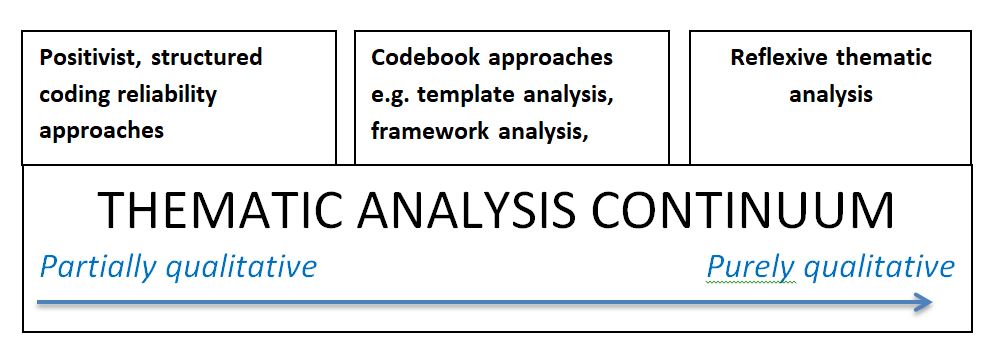Thematic analysis part 2: three schools of thematic analysis and study design recommendations
Posted on 6th March 2020 by Dolly Sud

This is the second of a three-part blog. The first blog provided an introduction to Thematic analysis (TA) and discussion of what a theme is, this blog provides a description of the three schools of TA and some study design recommendations, and the final blog provides an outline of the six phases of reflexive TA. A list of key reference sources is also provided.
Three schools of Thematic analysis (TA)
TA can be considered as being one of three broad “types” (schools) [2].
- Coding reliability
- Codebook
- Reflexive
These three titles emphasize the key distinctive element of each approach.
1. Coding reliability
- In these approaches themes are often conceptualized as domain summaries which have often been derived from data collection questions e.g. questions in a semi-structured interview with participants. These drive the coding process and are the output of the coding process.
- The process of coding aims to prioritize “reliable” data coding – in other words identification of “accurate” codes/themes within data.
- The identification of codes/themes is commonly based on agreement between multiple coders.
- Coding is guided by a codebook/coding frame, which contains a list of codes/themes – each has a label/name, a definition, information on how to identify the code/theme, a description of any exclusions or qualifications to identifying the code/theme, and data examples [7].
- The researcher categorizes the data into (pre-determined) themes. Ideally, the codebook is applied to the data by more than one coder, each working independently; for some, the ideal coder has no prior experience with or knowledge of the topic of concern and comes to the coding process naive.
- Accurate or reliable coding is calculated using Cohen’s kappa; this indicates the level of agreement between the coders. Lack of agreement is resolved.
- This process of coding is also known as consensus coding.
- Is viewed as being partially qualitative as consensus and calculation of accuracy/reliability is undertaken.
2. Codebook
- Some, if not all, themes are determined ahead of full analysis (e.g. again can be derived from data collection questions), and themes are typically conceptualized as domain summaries.
- Allows the researcher to include themes that have been derived from data collection tools and those that are generated from the data analysis process.
- As such, this method sits somewhere between “coding reliability” and “reflexive” TA as it shares the structured approach to coding like coding reliability TA (though commonly without the use of coding reliability measures) with the broadly qualitative underlying philosophy of reflexive TA.
- This type of TA includes template analysis and framework analysis approaches.
3. Reflexive
- In this type of TA, themes are conceptualized as meaning-based patterns which result from considerable analytic work on the part of the researcher.
- The researcher spends time exploring and developing an understanding of patterned meaning across the dataset.
- The process of coding is organic, open and iterative – and doesn’t involve the use of a codebook or coding frame.
- The process of coding is more flexible as the process of coding continues to encapsulate the researcher’s growing conceptualization of the data.
- The aim is to provide a coherent and compelling interpretation of the data, grounded in the data.
- This can and is often carried out by one person.
- The researcher is implicit in the generation of themes and this type of TA is not only purely qualitative but also subjective.
- Interpretation of the data, generation of codes and themes is underpinned by the researcher’s academic knowledge, theoretical assumptions, social position and cultural beliefs.
n.b. Reference for this section is Braun & Clarke (2019) [2].
Which approach should I use?
Ultimately, it is your choice. The key thing here is to remember to aim to be thoughtful in the process of data collection and analysis of the data you collect. Your aim should always be to produce a coherent piece of work. The use of structured codebook can introduce limits and boundaries which can take away from the depth of engagement and flexibility central to qualitative research practice [2]. Codebook approaches, however, are useful for teams of researchers and allow an easier and quicker approach to data analysis, providing structure for those new to qualitative research.
The diagram below summarises the three schools of TA.

Take home messages:
- If we consider TA on a continuum then the diagram above articulates the three schools.
- Whichever approach or school is chosen this must be done in a knowing way and clearly and explicitly articulated.
Study design recommendations when using TA [2]
- Locating your overall theoretical and interpretative frameworks is important. Research questions for TA need to be aligned with the theoretical orientation of your TA.
- TA offers flexibility around data collection methods: interviews and focus groups are often used. But other TA can be applied to many types of data including diaries, visual, surveys as well as secondary sources – such as online forums, blogs, and websites, to name but a few.
- Saturation as a marker for sampling adequacy is becoming increasingly accepted and expected as part of qualitative research. However, this has been the subject of much critical discussion [3, 8]. Some argue that the concept of saturation is not conceptually consistent with all forms of qualitative inquiry [8] and that sampling in qualitative research regard should be given to two key considerations appropriateness and adequacy or quality rather than the idea that one should and can continue to sample to the point at which no new information, codes or themes are yielded from data (aka theoretical saturation).
Again, I feel it is important to emphasize here that whichever approach is taken then paradigmatic and epistemological assumptions should be clearly articulated [3].


